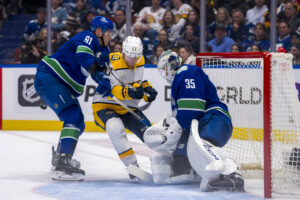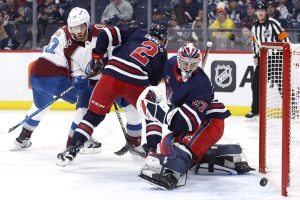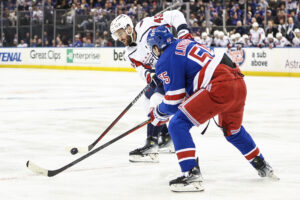The Vancouver Canucks officially announced the signing of Tanner Pearson and Thatcher Demko today. Both being made together despite the time difference implies the team is done with their free-agent deals. Certainly, until the trade deadline is complete, anyway. That is just as well, given the general reception to Pearson’s signing.
Tanner Pearson Breakdown
No, not of the Twitter variety, though there is plenty of that. We’ve talked a little about what the signing means to the team already. Now we’re taking a look at why it got done and why it’s a good – or lousy – deal.
Needful Things
You can only make a deal when someone’s got what you want. Here’s a look at what each side gets from the other.
Tanner Pearson
Like most of the players who sign in Vancouver, Pearson isn’t interested in leaving. Much of the wailing you may have heard was about his trade protections. That there is some shouldn’t be a surprise to anyone. A lot of the deals Benning is signing already have low initial payouts. In return, the players are going to want assurances they won’t be targeted for it. The protection is complete in year one and rapidly diminishes from there: seven teams in year two and no protection at all in year three.
The total value of the deal is $500,000 less per year than his current contract. That recognizes his reduced scoring, which is likely to continue through the deal. It’s still a hefty sum, brought up by a $1.5 million signing bonus due in 2023-24. Again, a symptom of the COVID-19 lockdown is back-heavy deals, and this qualifies. Depending on his performance, the bonus could be looked at as the cost of moving. If the team wants to ship him out, they will probably have to wait until they’ve paid that bonus to get a decent return.
To make all that work needed three years. As a player entering his 30’s soon, Pearson’s got to be happy with that deal. How about the team?
Vancouver Canucks
First off, let’s ignore the announcements. Every team is going to tell you they’re over the moon about any deal they sign and how it’s perfect in every way. What does the team actually need from Pearson to make this a good deal for them?
What Vancouver is getting is a solid defensive player with some scoring touch. Then again, in 88 games that scoring touch meant 30 goals and 57 points. Running at a 50+ point pace isn’t going to be his standard, but 40 could be. And given his use on the second line as the Canucks’ primary defensive forwards, those numbers aren’t bad at all. The expected goals from Pearson – Bo Horvat – Nils Höglander is currently 53.8 percent. That’s the equal of their top line of Elias Pettersson – J.T. Miller – Brock Boeser. That’s not an accident.
And Pearson finally ended the seemingly endless rotation of wingers skating with Horvat. It’s tough to overstate just how many experiments were conducted with the Canucks’ young star centre. It wasn’t until the end of Horvat’s fifth season that Pearson was brought in. And it worked.
The “value in the room” stuff is always hard to quantify, never mind put a value to. But there is no question that the team lost a lot of their leadership from last year. Wanting to avoid an off-season of upheaval could have played some part in the signing, too.
What’s the Worst That Could Happen?
Time. It’s always about time. As they say about boxers, Father Time remains undefeated, and Tanner Pearson’s name is coming up. He’s going to be 29 years old when the 2021-22 season starts, and that is not a kind time for athletes. Is his diminishing offence this year just reverting to his more typical norm? Part of the season’s overall weirdness? Or is it a preview of the expected fading numbers? For a team that is desperately waiting for bad deals to come off the books, three years is, at best, a risky proposition.
Then there’s the money. Both Pettersson and Quinn Hughes are negotiating deals in the off-season, and they are going to get paid, make no mistake. Adding a deal the size of Pearson’s now seems like an odd choice given the comparative roles. If his scoring does drop off to the point where he’s pushed to a third-line role, Pearson has the defensive chops to handle it well. He will still have some value. But the same could be said of Loui Eriksson.
Filling in the Blanks
There are young players who might be able to step up soon, but it won’t be next year. At least, not straight into the top-six. Vasili Podkolzin and Kole Lind are both top-notch prospects, but can they repeat what Höglander pulled off? It seems unlikely, and Pearson is already in town and wants to stay. Overall, we say that Tanner Pearson’s signing is a relatively low-risk deal, but at a too-high price.
What About Ty?
The instant refrain on hearing about this deal was “Why did Benning let Tyler Toffoli walk, then? Tanner Pearson is only being paid $1 million/year less!” Toffoli is, of course, having a ludicrous season which doesn’t compare to anything he’s ever done before. Anyone who tells you Toffoli is a 45-goal scorer has only started watching hockey this season. Oh, and the age thing? Toffoli’s four months older.
Comparing Pearson to an outlier, point-per-game season from Toffoli is more than a little unfair. He is a better scorer than Pearson, though, and he played great while he was here. So why wasn’t Toffoli kept? We talked about Benning’s decisions at the start of the season earlier, but in short? They couldn’t afford him.
The season started with no space on the cap. Suddenly finding another $4.25 million is a difficult task. Add to that, a younger, cheaper, and “finally-turned-the-corner” Jake Virtanen and the need for a winger was diminished. He was a gamble the Canucks took, and so far they lost.
Hat tips: MoneyPuck, CapFriendly
Main Photo:canucks






